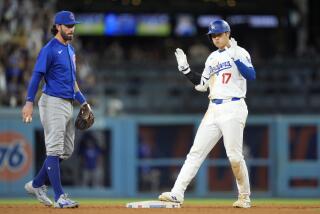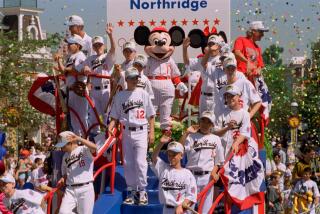Forget Fire, Chicago Had Real Disaster
- Share via
I’m an absolute sucker for good catastrophe stories. “The Bridge of San Luis Rey.” “The Last Days of Pompeii.” They were my favorite reading. I don’t know how many times I saw “The Towering Inferno” or watched the Titanic go down.
My favorite section of the Bible is Noah and the flood. I’d walk a mile to see a quadruple bogey. I wish I’d been in the San Francisco earthquake.
Which is why, I guess, I like Rick Talley’s new book about the terrible disaster that befell the great city of Chicago in the past.
The fire? Bah! The fire was nothing. Mrs. O’Leary’s cow did the town a favor.
No, I’m talking about a horror story that to this day makes a citizen of Chicago grow pale. His eyes get misted over and his lips tremble. It was a cataclysm from which the city may never recover.
It was, “The year the Cubs lost the pennant.” Again. 1969.
The Chicago Cubs are not a team, they’re a calamity. A municipal embarrassment. They’re the athletic equivalent of Inspector Clouseau. They made an art form of bumbling. They’d be funny if they weren’t so heartbreaking.
This is a team that hasn’t been in the World Series since 1945. Even when they got in them, they had some of the most celebrated pratfalls in the national pastime’s history.
Take, for instance, Game 4 of the 1929 Series. They took an 8-0 lead into the seventh inning. Before the inning was over, they trailed, 10-8. No team had ever given up 10 runs in an inning in Series play before. No team had ever blown an eight-run lead with two innings to play.
The Cubs were in the World Series four times between 1929 and 1938. They lost them all--two in four straight, one in four out of five and the other one in six games.
It was against the Cubs, interestingly enough, that Babe Ruth hit his famous called-shot Series home run in 1932. You could do things like that against the Cubs. Rub their faces in it, so to speak.
They not only haven’t been in a World Series in almost 45 years but the last one they were in was probably the worst of all time, played by returning out-of-shape war veterans or guys unfit for military duty in the first place.
So, the citizenry should have known better when the season of ’69 unfolded. But only the longtime fans cowered in corners, waiting for the iceberg to hit, the lava to flow, the bridge to snap.
The rest of the town was euphoric. The Bleacher Bums, Chicago’s version of the James Gang, were out in force daily, singing songs, chugging beer, jeering at the opposition.
The third baseman and captain was doing a daily click-your-heels dance on the dugout, the flags were flying, the cheers echoing--and the team built up a 9 1/2-game lead on the league. Magic numbers were being discussed.
After all, the team had Ron Santo, Ernie Banks, Billy Williams, Fergie Jenkins, Hall of Famers and near Hall of Famers. And it had the peerless leader, Leo Durocher himself, who it was said could take a troop of Boy Scouts and capture the Rhine.
The team closest to it was the New York Mets and they were an even bigger historical laughingstock than the Cubs. I mean, who couldn’t beat the New York Mets in that innocent year?
Well, it turned out that the Cubs couldn’t beat the Mets any more than they could beat that other New York team, the Yankees. The Cubs never even won a game in World Series play against the Yankees.
The Cubs beat the one team they could, the Cubs.
Talley’s book, “The Cubs of ‘69--Recollections of the Team That Should Have Been,” chronicles this municipal disaster, step by step. It’s like watching a baby carriage roll into the water.
The Cubs of ’69 were the first team to have agents, for instance. Cashing in on the municipal mania, an entrepreneur opened a thriving licensing business--coffee mugs, T-shirts, posters, baseballs--and divvied up the money among the sure Eastern Division winners.
It all began to go shudderingly in reverse some time after the middle of August, when the nine-game lead began to melt like spring ice on the Yukon.
That was almost 20 years ago, and the finger-pointing has not stopped yet. Chicago has never forgiven some of the principals.
As usual, when a ship runs aground, the captain gets put in the stocks. First of all, it was noted that, in this case, the captain jumped ship one weekend at the end of July when his crew faced a critical series with the Dodgers. Durocher, Captain Blood himself, skipped off to a boys’ camp, Camp Ojibwa, to visit his stepson, child of Leo’s new (third) bride. The camp was having Parents’ Day. The worst of it was, Leo had given out word that he missed the game because he was having “stomach disorders.”
That was nothing compared to the heartburn that hit Chicago when the team collapse set in soon after.
The autopsy of failure is relentless. There was enough blame to go around but, Leo, so to speak, got the lion’s share of it. Leo over-relied on his proven pitchers. Leo totally tired out his first-string players. Leo pushed the panic button. And so on.
To be sure, the Cub collapse was total. From a 9 1/2-game lead on Aug. 15, they not only managed to lose the division title to the expansion Mets, they lost it by eight games.
As collapses go, it was in the top 10. But there have been worse. The 1964 Philadelphia Phillies frittered away a 7 1/2-game lead with only 11 games to play and finished tied for second. The 1951 Brooklyn Dodgers had a 12 1/2-game lead in August but lost to the New York Giants. The 1978 Boston Red Sox let a 13-game lead disintegrate. Late-summer pratfalls were not the exclusive province of the 1969 Cubs.
Cub fans are not mollified. They point darkly to individual vignettes, cameos for a botched season--the home run Willie Stargell hit into the wind on a pitch that never should have been called. The ump’s call declaring the Mets’ Tommie Agee safe in a slide into home at Shea Stadium. The bitter rumor that the team was rocked with dissension because the manager carried paranoia and contentiousness around with him like a locker-room Typhoid Mary.
A less exciting conclusion would seem to be, the Mets were just probably a better team, maybe eight games better, at that. After all, this was a team that boasted Tom Seaver, Nolan Ryan, Jerry Koosman, Gary Gentry and Tug McGraw. You don’t need much more than that to get into a World Series.
That’ll never sell in Chicago. They know who to blame in Chicago. In fact, it probably wasn’t Mrs. O’Leary’s cow that kicked the lantern over. It was the Cubs.
More to Read
Sign up for The Wild
We’ll help you find the best places to hike, bike and run, as well as the perfect silent spots for meditation and yoga.
You may occasionally receive promotional content from the Los Angeles Times.






